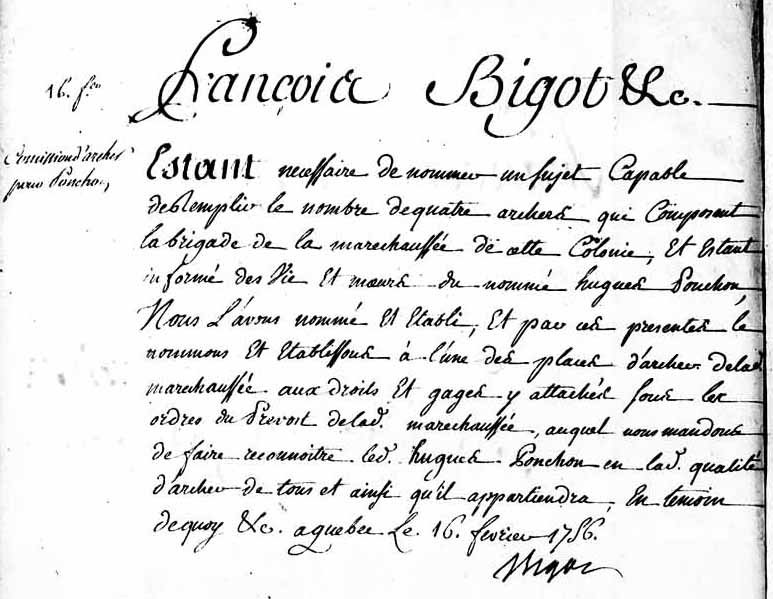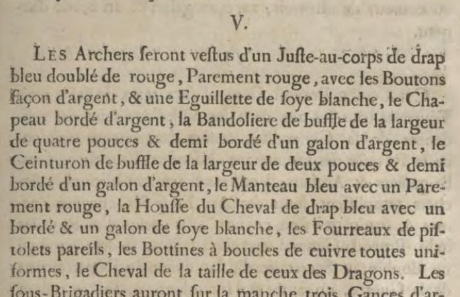Military rank of Archer in New France
Was your ancestor an “archer de la Marine” or an "archer de la Maréchaussée" in New France? Learn more about these important military functions in Canada’s early days.
Cliquez ici pour la version en français
L’Archer | The Archer
The Archer of the Navy
The archers of the Navy (“archer de la Marine”) served the intendants both in France and its colonies. They acted as escorts and guards at official ceremonies and were responsible for carrying out the orders of the intendants, including making arrests if necessary. When Jean Talon, the first intendant of New France, arrived in 1665, he was accompanied by two archers. His successors typically had one or two archers. However, Intendant Bigot, upon arriving in Quebec in 1748, increased his number to three for his personal service and added another to assist the commissioner of the navy in Montreal.
In the seventeenth century, the archers of the Navy wore casaques. Later, they wore blue velvet shoulder straps decorated with royal insignia and anchors. By the mid-18th century, their uniform had changed to red and blue.
Known Navy Archers: Pierre Lesaque, Jean Roger dit Saint-Jean, Pierre Souvigny
“Navy archer, in about the mid-eighteenth century” (drawing by Francis Back, Canadian Military History Gateway).
Archer of the Colony's Marshalcy
Established in Canada in 1677, the marshalcy was a body of law enforcement officers in Québec and Montréal known as "archers," headed by a prevost. These archers, or “archers de la Maréchaussée”, were the ancestors of modern police and gendarmes. Their primary duties included maintaining public order, combating crime, arresting criminals, and ensuring order during executions. Archers were often chosen from the ranks of former soldiers. The prevost, for his part, acted as a military commander, a police officer, and, when necessary, a junior prosecutor.
Unlike their mounted counterparts in France, archers in Canada primarily operated on foot. They frequently traveled long distances through dangerous terrain to track down criminals and deserters, using canoes, sleighs, or rented horses when necessary. They dealt with a variety of crimes, including murder, robbery, duels, prostitution, abortion, counterfeiting, sodomy, rape, and sorcery.
Commission as archer of the marshalcy of the colony by Intendant Bigot to Hugues Ponchon on February 16, 1756 (Bibliothèque et Archives nationales du Québec)
The marshalcy played a crucial role in the colony's justice system, enforcing the decisions of the colonial courts and providing security for government officials. Their uniforms and military status underscored their authority and the seriousness of their duties.
The archers' uniforms were prescribed by a royal ordinance issued on March 16, 1720:
“The Archers will be dressed in a blue cloth just-au-corps lined with red, with red trim, silver buttons and a white silk aiguillette, a hat edged in silver, a buffalo bandoleer four and a half inches wide edged with a silver braid, a buffalo belt two and a half inches wide edged with a silver braid, a blue coat with red trim, boots with copper buckles, all uniform.”
Archers were armed with swords, carbines, and sometimes pistols and polearms.
Extract of the 1720 ordinance (Société nationale de l’histoire et du patrimoine de la gendarmerie)
Known archers of the colony's Marshalcy: Dominique Aussion dit Petit, Louis Agathe dit Aussion, François Daubert, Charles David, Jean Delguel, Elie Dussault dit Lafleur, Jacques Gagnon, Pierre Jourdain, Jean Lecomte, Noël Levasseur, Étienne Maranda, Pierre Marcheteau dit Desnoyers, Louis Malouin/Marouin dit Saint-Louis, Jean Méchin, Jacques Morillon, Jean Petit, Hugues Ponchon dit Saint-Paul, François Raiche, Charles Rancourt, Jean Roger dit Saint-Jean, Claude Vincent Roussel dit Châteaufort, Léonard Tresny dit Laverdure
Sources:
Government of Canada, “The Police In New France: Navy Archers,” Canadian Military History Gateway (http://www.cmhg.gc.ca/cmh-pmc/page-158-eng.aspx). [Page no longer exists; can be viewed on Internet Archive at https://web.archive.org/web/20220916171230mp_/http://cmhg.gc.ca/cmh-pmc/page-158-fra.aspx)].
René Chartrand, "The Constabulary and Archers in New France,” Le Journal, Vol. 25, no. 3 Summer 2009, 1-5, Centre for French Colonial Studies.
René Chartrand, "La gouvernance militaire en Nouvelle-France," Bulletin d'histoire politique, 18(1), 2009, 125–136, digitized by Érudit (https://doi.org/10.7202/1054772ar).
"Ordonnance du 16 mars 1720," Société nationale de l’histoire et du patrimoine de la gendarmerie (https://www.force-publique.net/1720/03/16/ordonnance-du-16-mars-1720/).


